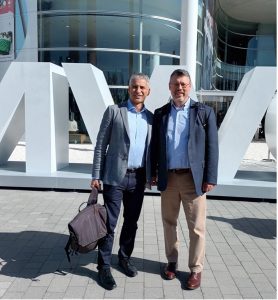Sam and I represented 4MC Partners last week at Mobile World Congress, in Barcelona.
While it is impossible to do justice to the scope of the show, which is back to peak attendance, there were key themes that drew our attention.
Are Mobile Operators writing checks they can no longer cash?
Major European Telcos are asking for a new deal with regulators. They are being hit across multiple dimensions; from high capex intensity to low revenue growth, from technology disruption to regulatory restrictions on spectrum and consolidation, trade unions…it’s really a business Rubik’s cube.
Given their positive impact on global GDP and on the lives of billions whose only connectivity is mobile, Telcos deserve a break and their World Appreciation Day!
Gen AI: Short-term evolutionary, long-term revolutionary
Every MWC show has its share of common beliefs that become show dogma.
This year, a few seconds into any meeting, the default small talk seemed to be around how so over-hyped Gen AI has become.
In reality, under the superficial dismissal, lay two unexpressed anxieties:
FONU – the fear of not understanding AI and its close relative FOMO – the fear of missing out.
There is simply too much at stake to ignore the trend and potential business impacts. Perhaps the most cogent thinking we heard came from Dr. Rainer Deutschmann, SVP at Telia.
In a panel, he set out some of the key adoption issues: the associated cost of tuning the underlying AI foundational models, the complicated culture changes required to operationalize these models and the need to be discriminating in use case selection to generate a positive RoI. He suggested to attendees that they reframe their organizational approach, thinking of theirs as “AI-first Enterprises”. “What new assets, capabilities and systems would I need if I was starting with a blank template for a firm today?”
Open RAN: From Crayfish to Brisket
The Open RAN issue has become also about national strategic industries and competitiveness, particularly in the US and Europe, rather than only about opening up network interfaces and disaggregating vendors’ control and pricing power.
This past December’s $14B Ericsson deal with AT&T, which includes an Open RAN roadmap, would have no doubt pleased Washington, the State Department, and the state of Texas (where Ericsson US is based) to name but a few interested parties.
Even if Ericsson is not an American Champion – which would require years to build up for scale – their ability to thread through multiple stakeholders is remarkable.
Other takeaways:
- Private Wireless: a new ecosystem is forming and is starting to pick up momentum that appears to bypass full-serve incumbents by making the tech cheap and easier to install. GSMA Intelligence Research shows that customer feedback on private 5G is broadly positive for 30% of the operators – up from 24% last year.
- Fixed Wireless Access: Boring is beautiful and the serendipitous use of 5G to provide economical connectivity to homes that cover the last 20% of households, is proving to be a winner for several operators including Verizon.
- Changing show demographics: we were pleasantly surprised to see more representation from women, and those of Saudi Telecom in particular. Also, as you walked from halls 1-3 to 7-8, the average age reduced by a third while the start-up and innovation buzz got correspondingly louder.
- RCS and API: these took some of the airtime, but we don’t see these as substantive positive trends, just yet. A key success factor is to attract developers who are incentivized to work upstream.

Sam and Jeff, “Made it to MWC Thursday!”
It’s been some years now that MWC is no longer representative of the Mobile Industry alone but has morphed into a much richer ecosystem or “Technology Bazaar”; that’s really good news as Telcos deal with some of the indignities of middle age.

